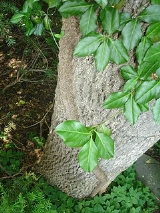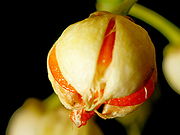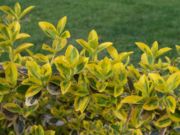
Euonymus fortunei
Encyclopedia
Euonymus fortunei, also commonly known as winter creeper or wintercreeper and Fortune's spindle is a species of Euonymus
native to east Asia, including China
, Korea
, Philippines
and Japan
.
 It is a woody
It is a woody
evergreen
vine
, growing to 20 m tall, climbing by means of small rootlets on the stems, similar to ivy
(an example of convergent evolution
, as the two species are not related). Like ivy, it also has a sterile non-flowering juvenile
climbing or creeping phase, which on reaching high enough into the crowns of trees to get more light, develops into an adult, flowering phase which does not have climbing rootlets.
The leaves
are arranged in opposite pairs, elliptic to elliptic-ovate, 2-6 cm long and 1-3 cm broad, with a finely serrated margin. The flower
s are inconspicuous, 5 mm diameter, with four small greenish-yellow petals. The fruit
is a four-lobed pale green pod-like berry, which splits open to reveal the fleshy-coated orange seed
s, one seed in each lobe.
There are two or three varieties
:
It is named after the plant explorer Robert Fortune
.
It has an extensive native range, including many parts of China (from sea level to 3400 m elevation), India, Indonesia, Japan, Korea, Laos, Myanmar, Philippines, Thailand, and Vietnam. It resembles Euonymus japonicus, which is also widely cultivated but is a shrub, without climbing roots. It also is related to a variety of similar species, including Euonymus theifolius, or Euonymus vagans and also a number of named "species" which are found only in cultivation and better treated as cultivars.
 It is widely cultivated as an ornamental plant
It is widely cultivated as an ornamental plant
, with numerous cultivar
s selected for such traits as yellow, variegated
and slow, dwarfed
growth. It is used as a groundcover
or a vine to climb walls and trees.
Plants propagated from mature flowering stems (formerly sometimes named "f. carrierei") always grow as non-climbing shrub
s. Some popular cultivars such as 'Moon Shadow' are shrub forms.
Most of the cultivated plants belong to var. radicans (Huxley 1992). It is generally considered cold hardy in USDA zones
5 to 9, and is considered an invasive species
in some parts of the world, notably the eastern United States
and Canada
.
Euonymus
Euonymus , often called spindle or spindle tree, is a genus of flowering plants in the staff vine family, Celastraceae. It comprises about 170–180 species of deciduous and evergreen shrubs and small trees...
native to east Asia, including China
China
Chinese civilization may refer to:* China for more general discussion of the country.* Chinese culture* Greater China, the transnational community of ethnic Chinese.* History of China* Sinosphere, the area historically affected by Chinese culture...
, Korea
Korea
Korea ) is an East Asian geographic region that is currently divided into two separate sovereign states — North Korea and South Korea. Located on the Korean Peninsula, Korea is bordered by the People's Republic of China to the northwest, Russia to the northeast, and is separated from Japan to the...
, Philippines
Philippines
The Philippines , officially known as the Republic of the Philippines , is a country in Southeast Asia in the western Pacific Ocean. To its north across the Luzon Strait lies Taiwan. West across the South China Sea sits Vietnam...
and Japan
Japan
Japan is an island nation in East Asia. Located in the Pacific Ocean, it lies to the east of the Sea of Japan, China, North Korea, South Korea and Russia, stretching from the Sea of Okhotsk in the north to the East China Sea and Taiwan in the south...
.

Woody plant
A woody plant is a plant that uses wood as its structural tissue. These are typically perennial plants whose stems and larger roots are reinforced with wood produced adjacent to the vascular tissues. The main stem, larger branches, and roots of these plants are usually covered by a layer of...
evergreen
Evergreen
In botany, an evergreen plant is a plant that has leaves in all seasons. This contrasts with deciduous plants, which completely lose their foliage during the winter or dry season.There are many different kinds of evergreen plants, both trees and shrubs...
vine
Vine
A vine in the narrowest sense is the grapevine , but more generally it can refer to any plant with a growth habit of trailing or scandent, that is to say climbing, stems or runners...
, growing to 20 m tall, climbing by means of small rootlets on the stems, similar to ivy
Ivy
Ivy, plural ivies is a genus of 12–15 species of evergreen climbing or ground-creeping woody plants in the family Araliaceae, native to western, central and southern Europe, Macaronesia, northwestern Africa and across central-southern Asia east to Japan and Taiwan.-Description:On level ground they...
(an example of convergent evolution
Convergent evolution
Convergent evolution describes the acquisition of the same biological trait in unrelated lineages.The wing is a classic example of convergent evolution in action. Although their last common ancestor did not have wings, both birds and bats do, and are capable of powered flight. The wings are...
, as the two species are not related). Like ivy, it also has a sterile non-flowering juvenile
Juvenile (organism)
A juvenile is an individual organism that has not yet reached its adult form, sexual maturity or size. Juveniles sometimes look very different from the adult form, particularly in terms of their colour...
climbing or creeping phase, which on reaching high enough into the crowns of trees to get more light, develops into an adult, flowering phase which does not have climbing rootlets.
The leaves
Leaf
A leaf is an organ of a vascular plant, as defined in botanical terms, and in particular in plant morphology. Foliage is a mass noun that refers to leaves as a feature of plants....
are arranged in opposite pairs, elliptic to elliptic-ovate, 2-6 cm long and 1-3 cm broad, with a finely serrated margin. The flower
Flower
A flower, sometimes known as a bloom or blossom, is the reproductive structure found in flowering plants . The biological function of a flower is to effect reproduction, usually by providing a mechanism for the union of sperm with eggs...
s are inconspicuous, 5 mm diameter, with four small greenish-yellow petals. The fruit
Fruit
In broad terms, a fruit is a structure of a plant that contains its seeds.The term has different meanings dependent on context. In non-technical usage, such as food preparation, fruit normally means the fleshy seed-associated structures of certain plants that are sweet and edible in the raw state,...
is a four-lobed pale green pod-like berry, which splits open to reveal the fleshy-coated orange seed
Seed
A seed is a small embryonic plant enclosed in a covering called the seed coat, usually with some stored food. It is the product of the ripened ovule of gymnosperm and angiosperm plants which occurs after fertilization and some growth within the mother plant...
s, one seed in each lobe.
There are two or three varieties
Variety (biology)
In botanical nomenclature, variety is a taxonomic rank below that of species: as such, it gets a three-part infraspecific name....
:
- Euonymus fortunei var. fortunei (syn. var. acutus). China, Korea.
- Euonymus fortunei var. radicans (Sieb. ex Miq.) Rehd. (syn. E. radicans). Japan.
- Euonymus fortunei var. vegetus (Rehd.) Rehd. Northern Japan (HokkaidōHokkaido, formerly known as Ezo, Yezo, Yeso, or Yesso, is Japan's second largest island; it is also the largest and northernmost of Japan's 47 prefectural-level subdivisions. The Tsugaru Strait separates Hokkaido from Honshu, although the two islands are connected by the underwater railway Seikan Tunnel...
), doubtfully distinct from var. radicans (Bean 1973).
It is named after the plant explorer Robert Fortune
Robert Fortune
Robert Fortune was a Scottish botanist and traveller best known for introducing tea plants from China to India.-Travels and botanical introductions to Europe:Fortune was born in Kelloe, Berwickshire...
.
It has an extensive native range, including many parts of China (from sea level to 3400 m elevation), India, Indonesia, Japan, Korea, Laos, Myanmar, Philippines, Thailand, and Vietnam. It resembles Euonymus japonicus, which is also widely cultivated but is a shrub, without climbing roots. It also is related to a variety of similar species, including Euonymus theifolius, or Euonymus vagans and also a number of named "species" which are found only in cultivation and better treated as cultivars.
Cultivation and uses

Ornamental plant
Ornamental plants are plants that are grown for decorative purposes in gardens and landscape design projects, as house plants, for cut flowers and specimen display...
, with numerous cultivar
Cultivar
A cultivar'Cultivar has two meanings as explained under Formal definition. When used in reference to a taxon, the word does not apply to an individual plant but to all those plants sharing the unique characteristics that define the cultivar. is a plant or group of plants selected for desirable...
s selected for such traits as yellow, variegated
Variegation
Variegation is the appearance of differently coloured zones in the leaves, and sometimes the stems, of plants. This may be due to a number of causes...
and slow, dwarfed
Dwarfing
Dwarfing is a characteristic in plants and animals whereby one or more members of a breed or cultivar are significantly smaller than standard members of their species...
growth. It is used as a groundcover
Groundcover
Groundcover refers to any plant that grows over an area of ground, used to provide protection from erosion and drought, and to improve its aesthetic appearance .- Ecosystem :...
or a vine to climb walls and trees.
Plants propagated from mature flowering stems (formerly sometimes named "f. carrierei") always grow as non-climbing shrub
Shrub
A shrub or bush is distinguished from a tree by its multiple stems and shorter height, usually under 5–6 m tall. A large number of plants may become either shrubs or trees, depending on the growing conditions they experience...
s. Some popular cultivars such as 'Moon Shadow' are shrub forms.
Most of the cultivated plants belong to var. radicans (Huxley 1992). It is generally considered cold hardy in USDA zones
Hardiness zone
A hardiness zone is a geographically defined area in which a specific category of plant life is capable of growing, as defined by climatic conditions, including its ability to withstand the minimum temperatures of the zone...
5 to 9, and is considered an invasive species
Invasive species
"Invasive species", or invasive exotics, is a nomenclature term and categorization phrase used for flora and fauna, and for specific restoration-preservation processes in native habitats, with several definitions....
in some parts of the world, notably the eastern United States
United States
The United States of America is a federal constitutional republic comprising fifty states and a federal district...
and Canada
Canada
Canada is a North American country consisting of ten provinces and three territories. Located in the northern part of the continent, it extends from the Atlantic Ocean in the east to the Pacific Ocean in the west, and northward into the Arctic Ocean...
.

